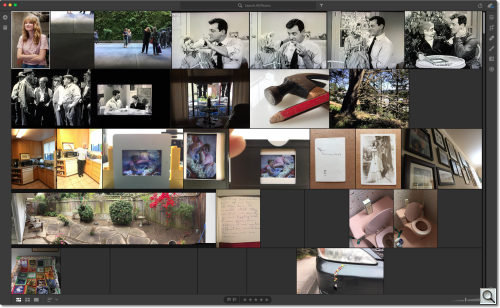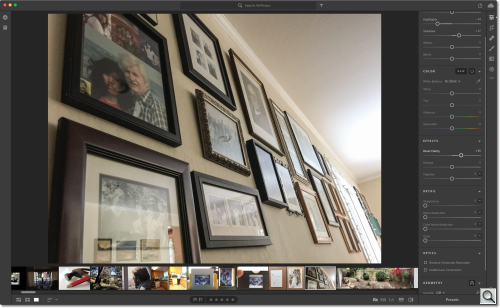Photo Corners headlinesarchivemikepasini.com
![]()
A S C R A P B O O K O F S O L U T I O N S F O R T H E P H O T O G R A P H E R
![]()
Enhancing the enjoyment of taking pictures with news that matters, features that entertain and images that delight. Published frequently.
Adobe Expands Photography Program With New Cloud Service




18 October 2017
At Adobe MAX today, Adobe has announced a revamped Creative Cloud Photography plan with several levels, adding a new version of Lightroom and expanded online storage options to the existing plan.
At the same time, the venerable versions of Lightroom and Photoshop got a much-needed code clean-up we find makes them a more pleasant experience than they have been in a while.
At a recent briefing, Tom Hogarty, senior product manager, described the shifting sands of modern photography as requiring a solution that is available anywhere and is both intuitive and powerful.
That was not, as it has turned out, Lightroom. And it certainly never was Photoshop.
NEW DIRECTION
But Adobe learned a lot from designing the limited interface to Lightroom mobile. And it has applied that knowledge to a new desktop product that greatly resembles it called Lightroom CC (while simultaneously renaming the old version Lightroom Classic).
That's an admission that it couldn't repaint the user interface of the old Lightroom. But it's also a concession to the modern requirement to store image data online rather than on your desktop.
Which, we quickly qualify, is a nod to smartphone photography, where a cloud is always following the photo.
But there are two important benefits to importing your images from your device to the cloud: 1) it makes them available on any device (including new ones) and 2) it gets them backed up on the server and by Adobe.
There's also a less obvious benefit. With your images stored in the cloud, they can be analyzed more conveniently for things like subject content and face recognition that is cumbersome to do on the desktop.
To evaluate which flavor of the plan will work best for you, then, start by asking where you want to store your images.
THE STORAGE ISSUE
If you shoot with a phone or regularly upload your shots to the cloud, cloud storage is your game.
It promises to make your images available to you whether you are using a phone, a tablet or a desktop computer. And with up to 1-TB of online storage now available, you've finally got some room to work with.
And not just for viewing but editing now too. Lightroom CC moves Lightroom mobile to the desktop so you can use the same interface on any device.
On the other hand, if you prefer to import your photos to your desktop computer, back them up to external drives, burn DVDs and otherwise manage your collection yourself, Adobe has not forgotten you.
LIGHTROOM
Far from it. It has recast the old familiar Lightroom as Lightroom Classic just 12 years after its introduction. And, from our experience running it the past week, it has polished it up quite a bit too.
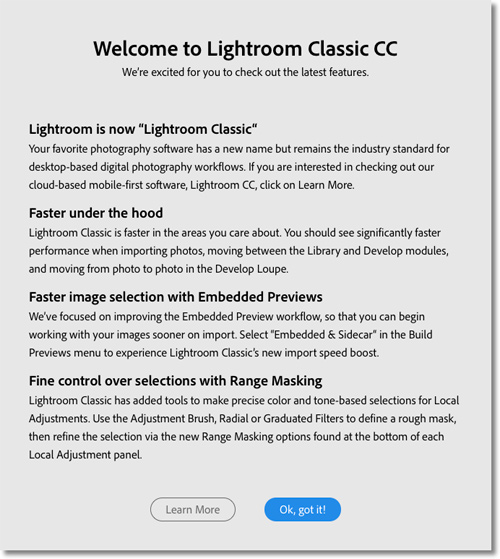
Lightroom Classic. It announced its own improvements.
We did last week's Friday Slide Show about the Campanile with it and didn't miss a beat. In fact for the first time in a long time, our Wacom Intuos II was, if not smooth as butter, less jittery when cropping and rotating.

Catalog Upgrade. Took a while.
This is also the version that delivers the performance enhancements Adobe promised, product manager Sharad Mangalick said. It's faster in every way, from launch, import, preview, moving to the Develop module and more. We didn't notice a great improvement in launch time but moving to Develop was instant. And, boy, do we appreciate that.
Hogarty said local folder management has also been improved with a more intelligent caching system.
Mangalick pointed out several enhancements including the new Range Mask Color with local adjustment, graduated filters and hair selection using Color, among the improvements.
Lightroom mobile got a nice update to its user interface. Here's a couple of screen shots:
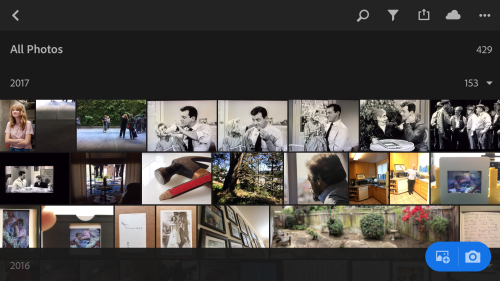
Lightroom mobile. A collection expanded by tapping on the date.
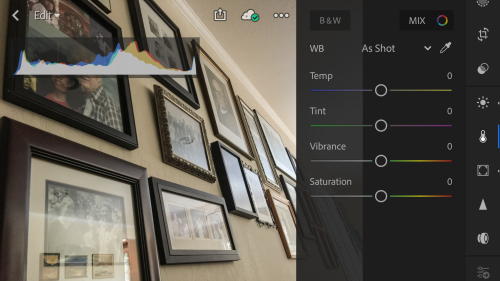
Lightroom mobile. An edit in progress with histogram overlay.
But the new Lightroom CC, which mimicks Lightroom mobile's new look, makes Lightroom editing more approachable than ever with a cleaner, icon-based user interface and helpful little popups to explain sliders when you hover over the label.
It imports your full-resolution images to the cloud (with some clever technology to handle offline importing) and you edit images stored in the cloud with just the edit recipes or metadata being uploaded and downloaded, not the pixel data. Collections have become Albums in the clouds.
Some things are missing. You don't have the output options of Lightroom Classic nor do you have Maps and a few other things like HDR and panorama building). But you can share easily enough via the Share icon.
One omission that Hogarty promised would be addressed is the lack of a Tone Curve in the new Lightroom CC.
It really feels like a desktop equivalent of the iOS experience of Lightroom mobile. With those limitations, too. A sort of Lightroom Lite.
All the cloud-based Lightroom versions (which excludes Lightroom Classic) tap into the Sensei search technology that does not depend on keywords. This requires the intensive kind of image analysis that can be done best in the cloud rather than on your desktop.
We gave it a try, looking for "car" in Lightroom CC and came up with all the cars plus the kitchen sink:
We tried a few other common nouns in our collection and found Search erred on the side of inclusion. Which, you know, is always good for a laugh. We retrieved some artwork, empty plates and Christmas ornaments when we searched for "food," for example.
On sad note about Lightroom: There will be no Lightroom 7 for perpetual license owners. Lightroom 6 will only be supported through the end of the year.
PHOTOSHOP
When it comes to improvements, Photoshop was not neglected.
It, too, enjoys the new hovering help popups, which Adobe calls Rich Tool Tips. But just on the toolbar, it seems, not in dialogs like the Camera Raw filter. That can't hurt anybody.
It also now offers a Learn panel with step-by-step tutorials. And they're quite good, pointing out what to do interactively. We liked them a bit better than the Guided Edits in Photoshop Elements, in fact. Even if they included a little cheerleading upon completion.
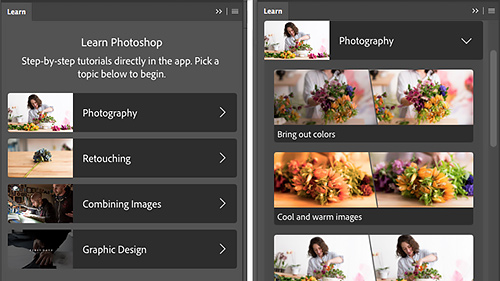
Learn Panel. Several topics (left) with various step-by-step tutorials.
There are a number of small improvements that make an impact, as well.
You can now access Lightroom photos from the Photoshop start screen. And you can import depth maps from HEIF files. You can also open and edit 360 spherical panoramas.

Start Screen. LR Photos points to Lightroom images and CC Files points to Creative Cloud files.
Along with painting performance improvements, Brushes enjoy preset management, enhanced presets and stroke smoothing.
Masking has been improved with more realistic and accurate results when selecting, faster Quick Masks and improved accuracy with Refine Edge. There's also a Range Mask in Camera Raw now.
This version also sport improvements in detecting skin tones and faces for improved protection of faces and improved face detection.
Performance improvements include faster New File launch time, blending/compositing, Surface Blur/Median Noise filters and the virtual memory system.
PNG quality and performance has also improved.
Adobe has already provided a sneak peek at its new Curvature Pen Tool and Variable Fonts support.
We've been using the new version Photoshop for about a week in production, working with type to reformat the ACA ad that appears on our Horn page and handling the images and thumbnails used in the stories we've published in Photo Corners.
We haven't had occasion to try all of the new and improved features but we've been very pleased with how Photoshop has performed our routine tasks.
THE PLANS
At launch, Adobe has tailored several different photography plans to provide a healthy selection of options that vary both in applications and levels of online storage. A current Photography Plan or Creative Cloud subscriber will see the addition of Lightroom CC in the Apps section of the Creative Cloud app to activate the plan, Adobe told us.
The available plans include:
- All-in-One. If you want an all-in-one plan with the new Lightroom CC service plus Photoshop, the Creative Cloud Photography plan with 1-TB of data includes Lightroom CC, Lightroom Classic, Lightroom for mobile and Web, Photoshop CC, Adobe Spark with premium features, Adobe Portfolio and 1-TB of cloud storage for $19.99/month (but available at $14.99/month for the first year for existing Creative Cloud Photography customers). The whole ball of wax.
- Existing Plan Upgrade. Lightroom CC has also been added to the existing Creative Cloud Photography plan with an additional 20-GB of storage to help you get started on the new service. This plan remains at $9.99/month and includes Lightroom CC, Lightroom for mobile and Web, Lightroom Classic, Photoshop CC, Adobe Spark with premium features, Adobe Portfolio and 20-GB of cloud storage. Creative Cloud All Apps members also have access to the new Lightroom CC service.
- 1-TB Cloud Only. This is a new plan to address the needs of photographers who want a cloud-based photography service for editing organizing, storing and sharing their photos from wherever they are. It includes Lightroom CC, Lightroom for mobile and Web, Adobe Spark with premium features, Adobe Portfolio and 1-TB of cloud storage ($9.99/month). No Photoshop or Lightroom Classic.
- 100-TB Mobile Only. For those who are truly mobile and don't require a desktop photography solution at all, the Lightroom Mobile plan for iOS and Android is available with 100-GB of cloud storage ($4.99/month).
For more information on available plans, visit the Adobe plans page.
For more information about the changes to Creative Cloud see the blog post Redefining Modern Creativity With the Next Generation of Creative Cloud and the news release below.
Adobe Introduces New Lightroom CC Cloud Photography Service
Integrated Cloud-based Service Enables Easy Editing, Organizing, Storing and Sharing of Photography From Anywhere
LAS VEGAS, Nev. -- Adobe has announced the all-new Adobe Photoshop Lightroom CC cloud-based photography service. Launched over a decade ago, Lightroom became the industry's leading desktop application for editing and organizing photography. Now in an increasingly mobile-centric world and with major improvements in smartphone cameras, Lightroom is transforming digital photography again. Built for professionals and enthusiasts, the new Lightroom CC fulfills the demands of today's photographers for a more accessible, cloud-based photography service for editing organizing, storing and sharing their photos from wherever they are.
Featuring a streamlined user interface, Lightroom CC enables powerful editing in full resolution across mobile, desktop and the Web. With Lightroom CC, photographers can make edits on one device and automatically synchronize their changes everywhere. Lightroom CC makes organizing photography collections easier with features like searchable keywords that are automatically applied without the hassle of tagging. And Lightroom CC makes it simple to share photos on social media.
"As the leader in digital photography, today Adobe is unveiling Lightroom CC, our next generation photography service," said Bryan Lamkin, executive vice president and general manager, Digital Media at Adobe. "Lightroom CC answers photographers' demand for a deeply integrated, intelligent, cloud-based photography solution."
Key Lightroom CC capabilities include:
- The most powerful image editing technology: Built on the same imaging technology that powers Photoshop and Lightroom, Lightroom CC offers a new streamlined interface with easy-to-use sliders, presets and quick adjustment tools.
- Edit anywhere: Lightroom CC allows photographers to edit full-resolution photos anywhere -- on mobile devices, desktop or the web. Edits made on one device are automatically synced across devices for anywhere access.
- Worry free back-up, cloud storage: Lightroom CC has scalable storage options for safe and secure back up of full resolution photos -- including Raw files.
- Powered by Adobe Sensei: Adobe Sensei uses machine learning to automatically apply searchable keywords to objects in photographs -- making organization in Lightroom CC effortless.
- Built-in sharing tools: Lightroom CC makes it easy to share photos directly via social media and to create custom Lightroom web galleries that can be shared via link. Photographers can also share their work through new Adobe Portfolio integration with Lightroom CC.
- Updated award-winning mobile and web experiences:
o Lightroom CC for mobile on iOS: Built-in search functionality powered by Adobe Sensei, keyword support,
hierarchical album support, an enhanced iPad app layout and iOS 11 files support.
o Lightroom CC for mobile on Android: Tablet support and a local adjustments brush, along with the same built-in search functionality, keyword support and hierarchical album support as seen in the iOS app.
o Lightroom CC for web: Ability to create and manage a public gallery page and enhanced integration with Adobe Portfolio, which enables subscribers to easily import collections and publish their best shots to a customized Portfolio Web site in just a few clicks.
Updates to Adobe Photoshop Lightroom Classic CC
Previously known as Lightroom CC, major updates to Lightroom Classic CC include an enhanced Embedded Preview workflow that enables users to scroll through large sets of photos to select a subset of images significantly faster than before. Lightroom Classic CC also features new editing capabilities, including a new Color Range and Luminance Masking functionality that enables users to apply precise edits. As contrasted with the cloud-centric, anywhere workflows of Lightroom CC, the new Lightroom Classic CC continues to focus on a more traditional desktop-first workflow with local storage and file and folder control.
Availability, Plans and Pricing
The all new Lightroom CC is available across three photography plans:
- For photographers that want an all-in-one plan that offers the full benefits of the Lightroom CC service plus the transformative power of Photoshop, the Creative Cloud Photography plan with 1 TB includes Lightroom CC, Lightroom Classic, Lightroom for mobile and web, Photoshop CC, Adobe Spark with premium features, Adobe Portfolio and 1 TB of cloud storage ($19.99/month, but available at $14.99/month for the first year for existing Creative Cloud Photography customers)
- Lightroom CC has also been added to the existing Creative Cloud Photography plan with an additional 20-GB of storage to help users get started on the new service. This plan remains at $9.99/month and includes Lightroom CC, Lightroom for mobile and web, Lightroom Classic, Photoshop CC, Adobe Spark with premium features, Adobe Portfolio and 20-GB of cloud storage. Creative Cloud All Apps members also have access to the new Lightroom CC service.
- The all new Lightroom CC plan addresses the needs of photographers who want a cloud-based photography service for editing organizing, storing and sharing their photos from wherever they are and includes Lightroom CC, Lightroom for mobile and web, Adobe Spark with premium features, Adobe Portfolio and 1 TB of cloud storage ($9.99/month)
For those who are truly mobile and don't require a desktop photography solution, the Lightroom Mobile plan for iOS and Android is available with 100-GB ($4.99/month).
For more information on available plans, please visit https://www.adobe.com/creativecloud/plans.html.
